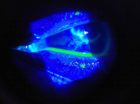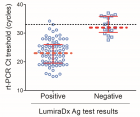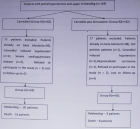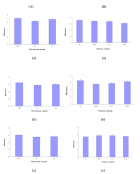Table of Contents
Silicon rates and beneficial microorganism on blast suppression and productivity of upland rice
Published on: 2nd April, 2021
OCLC Number/Unique Identifier: 9026721019
One of the primary constraints in upland rice cultivation is the disease blast (Magnaporthe oryzae), which can provide reduction up to 100% of the grain yield The use of silicon with beneficial microorganisms (bioagents) can be an alternative for the control of this disease and to provide an increase in the productivity of the rice grain. The objective of this work was to study the effect of rates of silicon with bioagents in blast suppression and grain yield of upland rice. The methodology used was tests carried out in field conditions, in two different areas: Capivara and Palmital farms, during the growing season 2015/2016. The experimental design was in a split-plot scheme with four replications. In the main plots were the silicon fertilization rates (0, 2, 4 and 8 ton ha-1) and in the subplots was the bioagents (1-without bioagents, 2-Pseudomonas fluorescens, 3-Burkholderia pyrrocinia, 4-Trichoderma asperellum, 5-a mixture of the three bioagents). The results showed that the use of 2 ton ha-1 of silicon with a mixture of bioagents was the best treatment to control leaf blast. Besides, from rates, 2 to 6 ton ha-1 of silicon in Capivara Farm and up to 8 ton ha-1 of silicon in Palmital Farm provided the highest grain yield. A mixture of bioagents provided the highest grain yield. In this sense, it was concluded that the best recommendation to connect blast control, grain yield and reduced amount of silicon was the use of 2 ton ha-1 of silicon with the mixture of bioagents.
An experimental study on effects of fluoridated water on Abelmoschus esculentus var. Soh-198 (Lady Finger) Arshi Iram*
Published on: 23rd March, 2021
OCLC Number/Unique Identifier: 8983555712
An experimental study of fluoride (F) accumulation in Abelmoschus esculentus var. Soh-198 and its effect on the growth and crop yield was conducted in a pot experiment. Eight different concentrations of F in the water were used for irrigation ranging from 2 to 14 ppm with distilled water as the control. Potentiometric determinations of the F content in different parts of the plant were made 45, 60, and 120 days after sowing the seeds (first, second, and third harvest, respectively). At the third harvest the highest mean plant part concentrations of F were recorded with 14 ppm F in the irrigation water: 9.0638 mg/kg in the roots, 5.6896 mg/kg in shoot, 4.5348 mg/kg in leaf and 3.563 mg/kg in fruit.
Fluorinated nematicides: Novel classes in the way
Published on: 19th February, 2021
OCLC Number/Unique Identifier: 8983551820
The demand on non- fumigant nematicides was strongly increased in the last few years, and this interesting in nematicides are due to farmers are needed for safer pesticides and increasing of the regulatory pressure on many of the traditional nematicides. The control of plant parasitic nematodes with synthetic nematicides is the most widespread and preferred method, but not always effective enough. The most of synthetic nematicides especially non-fumigants are high toxic to non-target organisms. Thus, Novel non-fumigant nematicides were appeared as alternatives.
The group of trifluoromethyl contains both fluensulfone and fluopyram which are different in mode of action than traditional nematicides as organophosphate and carbamate. Meanwhile, results indicated that fluensulfone and fluopyram are promising nematicides. These new nematicides are very different from traditional nematicides; they are more selective, less toxic and safer to use.
Characterization and virulence determination of Colletotrichum kahawae isolates from Gidami, Western Ethiopia
Published on: 5th February, 2021
OCLC Number/Unique Identifier: 9004617933
Coffee is one of the most essential crops that generate income for Ethiopian economic growth. However, its production faced with many factors primarily biotic entities. Among these, the fungal pathogen /Colletotrichum kahawae/ that induce coffee berry disease (CBD) is the main constraint of coffee production in the country. The pathogen is a very specialized and infects the green berries/fiscal par/which diminishes the income gained from it and disturbs the country’s economy in general and the producers in particular. Regarding to the disease level and related factors, little information is available in Western Ethiopia. Hence, this study was initiated to assess the magnitude of CBD in coffee fields, to characterize and evaluate the virulence of C. kahawae isolates from the study areas of Gidami district. Assessment was done in 9 selected kebeles of 45 total farms starting from July 2017. The results indicated that CBD was prevalence in all assessed areas with the range of 66% to 86% and 16% to 50% disease incidence and severity index (SI), respectively. The highest CBD intensity was observed in higher altitude with a significant positive correlation between disease incidence (r = 0.61) and severity (r = 0.55). Macro and microscopic characterization results revealed isolates diversity in terms of colony color, density, mycelia growth rate and conidial production. Moreover, mycelia growth rate differs significantly (p < 0.001) in the range between 2.2 to 4.3 mm/24 hrs. Similarly, the sporulation capacity widely ranged from 186.1 to 572.3 spores/ml. This were strongly agreed with the virulence test that revealed significant variation (p < 0.001) among isolates and infection percentage also ranged between 34.8% and 88.7%. In all, the study was not only showed the CBD is very important disease of coffee in the study area but also determines the virulence disparity among isolates. To be honest, the diversity/identity of C. kahawae isolates should be confirmed using more other reliable methods thru including additional sample areas as well.
Alternative method for the transformation of Capsicum species
Published on: 2nd February, 2021
OCLC Number/Unique Identifier: 9004613881
Capsicum (pepper) species have high economic values as vegetable crops and medicinal plants. Most of the Capsicum is known to be recalcitrant to plant regeneration in vitro, and to genetic transformation with Agrobacterium tumefaciens. However, genetic improvement against pathogens requires discovering new pest resistance genes and revealing their functions and mechanism in vitro. The development of improved transformation methods serves this purpose, which needs a binary vector technology carrying the gene of interest to be transferred into the host plants. Agrobacterium rhizogenes mediated transformation serves as a useful alternative way for the Capsicum transformation. The A. rhizogenes transformation compared to the A. tumefaciens transformation has the advantage that the method needs no regeneration step in vitro.
Our goal is to obtain a highly efficient transformation system that can be used to study the functions of different genes in Capsicum annuum varieties. Our study’s further goal is to validate and describe the candidate gene (Me1) involved in resistance against root-knot nematode species.

HSPI: We're glad you're here. Please click "create a new Query" if you are a new visitor to our website and need further information from us.
If you are already a member of our network and need to keep track of any developments regarding a question you have already submitted, click "take me to my Query."

























































































































































